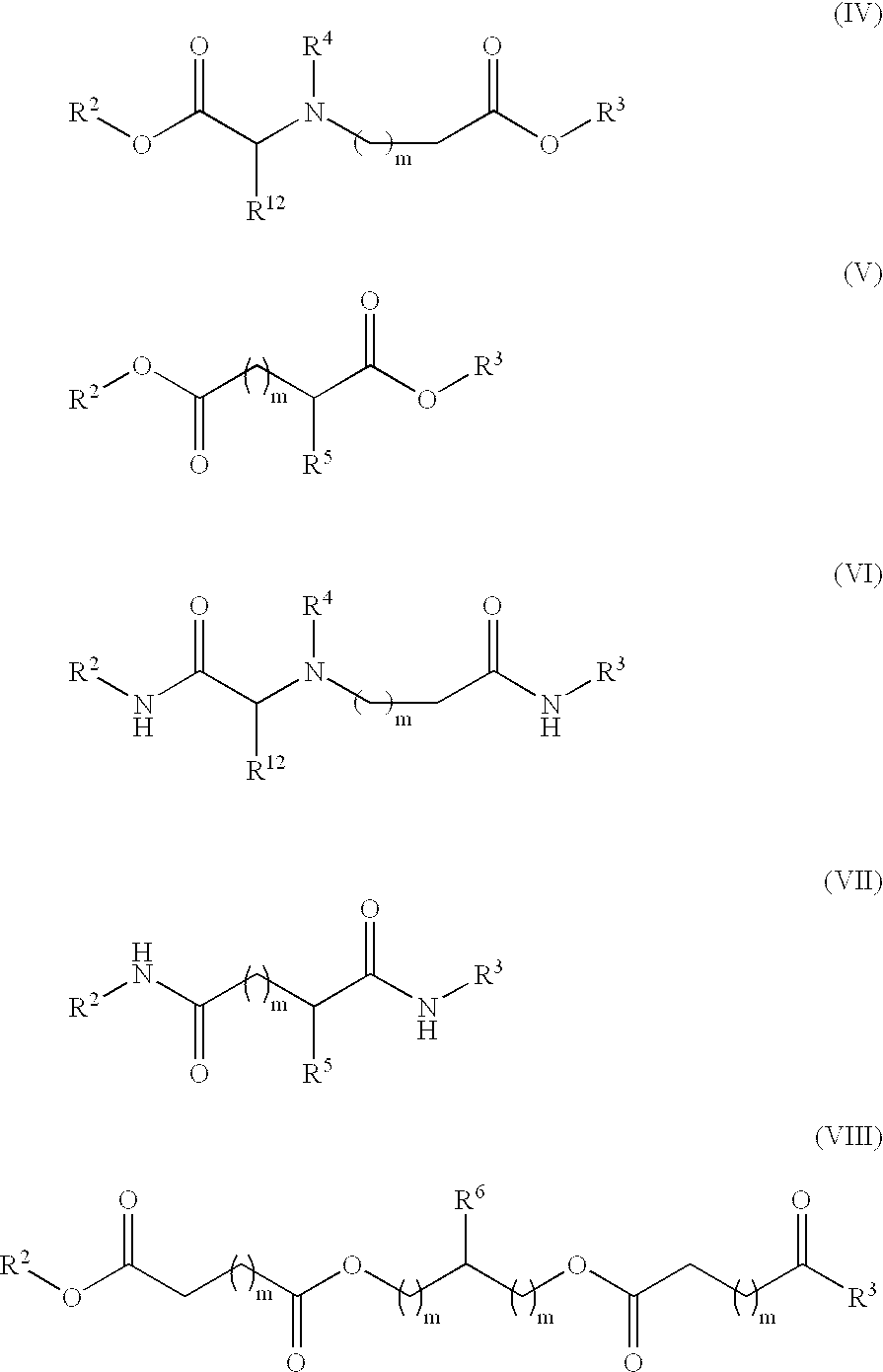Degradable polyacetal polymers
- Summary
- Abstract
- Description
- Claims
- Application Information
AI Technical Summary
Problems solved by technology
Method used
Image
Examples
example 1
Synthesis of Polyacetal 3 by Polymerization in Toluene
[0152] 16
[0153] Poly(ethylene glycol) (Mn=3,400 g / mol, 17.0 g, 5.0 mmol, 1.0 eq), para-toluenesulfonic acid monohydrate (0.03 g, 0.15 mmol, 0.03 eq) and toluene (60 ml) were added to a 100 ml round bottom flask which was equipped with a stirring bar and fitted with a thermometer, Dean Stark trap and condenser. An azeotropic distillation of the stirred toluene solution (oil bath, T=150.degree. C.) under nitrogen proceeded for two hours. The solution was then allowed to cool to .about.50.degree. C. and tri(ethylene glycol) divinyl ether (1.073 g, 1.083 ml, 5.2 mmol, 1.04 eq) was added by syringe. Within one minute the reaction mixture became visibly more viscous and after 15 minutes the viscosity appeared to be very high. Toluene (30.0 ml) was added to decrease the viscosity and the clear colorless reaction mixture was stirred a further 2 hours at ambient temperature. Aqueous NaHCO.sub.3 (8.0%, 2.0 ml) was added to the reaction mix...
example 2
Synthesis of Polyacetal 3 by Polymerization in THF
[0154] A suspension of PEG.sub.3400 (1.041 g, 0.306 mmol) and para-toluenesulfonic acid (25 mg) in toluene (50 ml) was heated to reflux; the flask was fitted with a Dean and Stark trap and a balloon of argon was fitted to the condenser. After 150 min most of the toluene was distilled off. To the residue was added the divinyl ether (0.306 mmol, 1.0 eq) in freshly distilled THF (10 ml). The mixture was stirred at room temperature under argon for 16 h. Triethylamine (0.2 ml) was added and the mixture was stirred for 5 minutes. The mixture was poured into hexane (300 ml) with rapid stirring, after 5 min the hexane was decanted off and the residue was washed with further hexane (200 ml) for 30 minutes. The polymer was filtered off.
[0155] This same procedure was used for polymerizations conducted in dichloromethane.
example 3
Synthesis of Bis-Vinyl Ethers Useful for Preparing Polyacetals
[0156] The vinyl ethers were made from methyl esters using the commercially available amino vinyl ether. This avoided the use of heavy metals to make the vinyl ether moiety. 17
[0157] A solution of 3-amino-1-propanol vinyl ether 5 (0.27 mmol, 2.2 eq) and dimethyl malonate 4 (0.12 mmol, 1 eq) in dichloromethane (5.0 ml) was stirred at ambient temperature for 3 days. The reaction mixture was diluted with dichloromethane (50 ml) and washed with water (2.times.35 ml), conc. NaCl solution (35 ml) and dried over MgSO.sub.4. The solvent was evaporated to give a semi-solid residue which was triturated with ether-hexane (1:1) to give the bis vinyl ether 6.
PUM
| Property | Measurement | Unit |
|---|---|---|
| Angle | aaaaa | aaaaa |
| Temperature | aaaaa | aaaaa |
Abstract
Description
Claims
Application Information
 Login to View More
Login to View More - R&D
- Intellectual Property
- Life Sciences
- Materials
- Tech Scout
- Unparalleled Data Quality
- Higher Quality Content
- 60% Fewer Hallucinations
Browse by: Latest US Patents, China's latest patents, Technical Efficacy Thesaurus, Application Domain, Technology Topic, Popular Technical Reports.
© 2025 PatSnap. All rights reserved.Legal|Privacy policy|Modern Slavery Act Transparency Statement|Sitemap|About US| Contact US: help@patsnap.com



